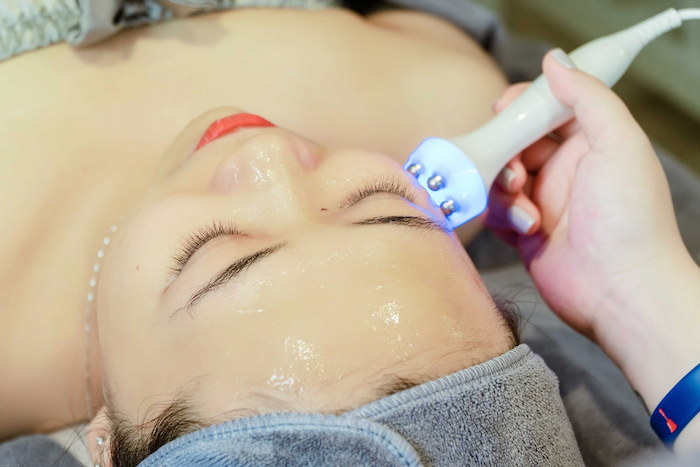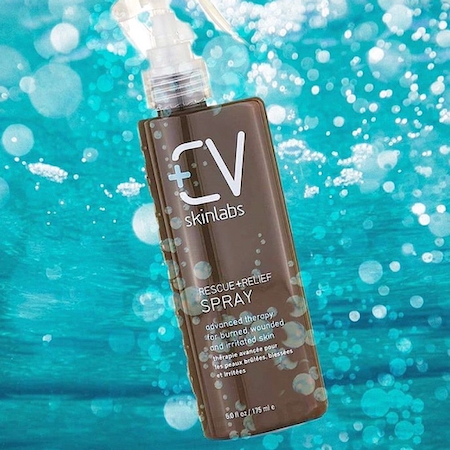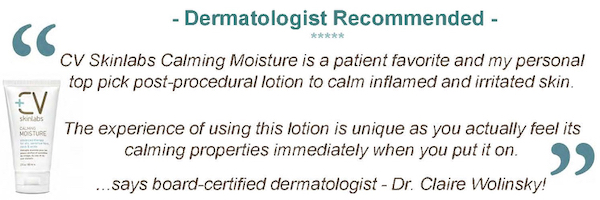
Post-procedure skincare can be a little overwhelming.
Maybe you just had a resurfacing laser treatment, chemical peel, or microneedling appointment.
How do you take care of your skin afterward to speed healing and make sure your skin looks its best?
We have ten tips for you. But first, let’s look at what happens to the skin after a procedure.
Why is Post-Procedure Skincare Important?
Your skin needs extra TLC after a cosmetic procedure. In most cases, it’s been wounded in some way. Even though the treatment is likely to encourage an improved appearance in the future, the immediate results are likely to include inflammation, redness, swelling, sensitivity, irritation, and a compromised skin barrier.
If you’re not careful at this stage, you can damage the skin, which may result in permanent scarring and discoloration.
Your physician will likely give you some instructions on how to treat your skin after the treatment to help encourage healing and prevent damage. Follow these instructions carefully and be patient. Your skin will need time to heal.
10 Tips for Post-Procedure Skincare
1. Avoid the Sun
This is an absolute must after any sort of cosmetic procedure. The compromised outer barrier of the skin is extremely vulnerable to the sun’s ultraviolet (UV) rays. If you expose such delicate skin to the sun, you risk damaging it permanently and your skin could look worse than before you got the treatment.
Play it safe by avoiding the sun completely until your skin starts to heal. Stay indoors, and use hats and umbrellas if you must go out. When your skin is ready, continue to be cautious by using a physical sunblock (zinc oxide or titanium dioxide) every day until it is completely healed.
Post-Procedure Skincare 2. Be Gentle
While you want to keep skin clean after a procedure, you need to be super gentle while it’s recovering. That means avoiding harsh cleansers or even those with acids like salicylic or glycolic. Use only the most gentle, creamy cleanser until your skin has returned to normal. Then pat—don’t rub—dry.
3. Use Cold Compresses
If your skin is red, irritated, and swollen, use cold compresses or frozen veggies over the area for 10 minutes at a time. This can help take down the swelling while reducing any pain or irritation you may be feeling.
4. Avoid Any Harsh Ingredients
There are many ingredients in skincare products that can be too harsh after a cosmetic procedure. It’s best to avoid all of these while your skin is healing. Check the ingredient labels and use only the gentlest products.
- Retinols
- Acids (glycolic, salicylic, malic, lactic, and others)
- Benzoic acid
- Benzoyl peroxide
- Ascorbic acid (vitamin C)
- Preservatives (parabens, ureas)
- Fragrances
- Chemical sunscreens (oxybenzone, avobenzone)
- Astringents (or products with alcohol)
Post-Procedure Skincare 5: Calm and Soothe the Skin
A calming or cooling mask or mist can be soothing post-treatment, but be careful of what you’re using. Make sure that the ingredients are gentle and safe.
If skin is too tender and irritated to touch, we recommend starting with our Rescue + Relief Spray. It will instantly bring cooling relief to stressed skin with ingredients that tame inflammation and redness while imparting a cooling and soothing effect.
A light moisturizing effect also encourages the skin to heal, supporting optimal healing and treatment results.
6. Moisturize Regularly
What your skin needs most of all after treatment is moisture. A lack of moisture could delay the healing process and cause extra dryness, flakiness, and scabbing in certain areas.
Again, you have to be careful. Make sure that the moisturizer you’re using does not include harsh ingredients. We recommend our Calming Moisture and Body Repair Lotion. Both were created and approved for medically treated skin and will restore moisture and encourage healing.
Natural moisturizing oils absorb easily into the skin while nourishing and rebuilding the skin’s protective barrier, supporting the production of new, healthy elastin and collagen, which will preserve your procedure results.
Both also have protective antioxidants and anti-inflammatory ingredients that will help calm redness and peeling while soothing inflammation and irritation from the after-effects of a treatment.
Dr. Claire Wolinksy, a board-certified dermatologist at Berkowitz Dermatology in NYC (and clinical instructor at Mount Sinai Hospital and Elmhurst Hospital) says:
“CV Skinlabs Calming Moisture is a patient favorite and my personal top pick post-procedural lotion to calm inflamed and irritated skin. After microneedling and laser devices, this lightweight yet hydrating lotion instantly soothes and restores freshly treated skin. The experience of using this lotion is unique as you actually feel its calming properties immediately when you put it on. I highly recommend it to patients just starting retinoid or retinol products as well.”
7. Limit or Avoid Makeup
Check with your doctor. Depending on which treatment you received, it may be best to avoid makeup completely for at least a few days. For some milder treatments, you can still use makeup, but it’s best to limit your application to a few simple products.
Think tinted moisturizer, a bit of mascara (unless you treated your eyes), and a lip gloss. Check the ingredients in all of them—particularly the tinted moisturizer—to be sure that they’ll be safe for the skin.
You could try mixing your regular liquid foundation with our Calming Moisture to create your own safe tinted moisturizer.
Post-Procedure Skincare 8. Avoid Picking at Your Skin
As your skin starts to heal, you may notice some itching or scabbing. Avoid picking or scratching at all costs! If it’s bothering you, use cold compresses, ice packs, or an anti-itch cream to address the irritation.
Depending on the procedure, your physician might recommend a product to further help seal in moisture. Our Restorative Skin balm not only creates a safeguarding moisture barrier (to lock in moisture) but is full of healing ingredients that rebuild and support cell renewal while speeding up the healing process dramatically. Plus it’s petroleum-free and 100% natural.
Apply our Restorative Skin Balm to any areas that need some extra TLC and moisture. This extra-rich healing ointment works quickly to speed healing and relieve redness and bruising.
In general, it’s best to avoid touching your face with your fingers unless you have just washed them. Your fingers have oils and bacteria on them that you could transfer to your face, which could increase your risk of infection. So hands off!
9. Avoid Exfoliating
This may go without saying, but don’t exfoliate your skin. Your procedure likely removed any dead skin cells on the surface, so you won’t need any exfoliation for a while. Exfoliating too early could damage the skin.
This also means avoiding the use of skin brushes or harsh wash clothes that could have a slight exfoliating action. Use only clean fingers.
10. Build Back the Skin’s Barrier
Since any cosmetic procedure is likely to compromise the skin’s outer barrier, you can help the skin recover by restoring that barrier. This will help protect the skin from bacteria and other environmental irritants that may interfere with the healing process.
To do this, continue to conduct a normal twice-daily skincare routine, where you gently cleanse, tone (with our Rescue + Relief Spray), and moisturize. Stay away from anti-aging serums and other products with more aggressive ingredients for a while, and avoid moisturizers with petrolatum in them. They can retain redness and heat in the skin.
Then once your skin starts to heal, you can ease back into your other products.
How do you care for your skin after a cosmetic procedure?




